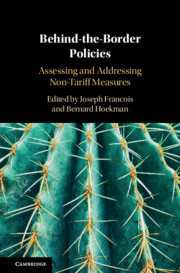Book contents
- Behind-the-Border Policies
- Behind-the-Border Policies
- Copyright page
- Contents
- Figures
- Tables
- Boxes
- Contributors
- 1 Moving beyond the Border
- Part I Concepts and Measurement
- Part II Assessing and Benchmarking Policy
- Part III Dealing with Non-tariff Measures: Legal and Institutional Contexts
- References
- Index
1 - Moving beyond the Border
Introduction and Overview
Published online by Cambridge University Press: 25 October 2019
- Behind-the-Border Policies
- Behind-the-Border Policies
- Copyright page
- Contents
- Figures
- Tables
- Boxes
- Contributors
- 1 Moving beyond the Border
- Part I Concepts and Measurement
- Part II Assessing and Benchmarking Policy
- Part III Dealing with Non-tariff Measures: Legal and Institutional Contexts
- References
- Index
Summary
Over the last three decades, traditional barriers to trade – import tariffs and quantitative restrictions (QRs) – have fallen dramatically. Globally, average applied import tariffs are less than 10 percent, and are well below 5 percent in Organisation for Economic Co-operation and Development (OECD) countries. Quantitative import restrictions have become rare outside of agriculture and even there today mostly take the form of so-called tariff rate quotas where higher tariffs apply once a certain quantity of imports (the quota) has been exceeded. Many inputs used in production are duty-free if imported. The decline in tariffs and QRs was a driver of a boom in international trade flows in the 1990s and 2000s and supported major changes in the structure and composition of world production and trade as this came to be organized in global value chains (GVCs). Tariff reductions, complemented by technological and managerial advances, drive firms to specialize in specific tasks and activities. International supply chains and production networks are the mechanisms through which this process of specialization is organized, with production occurring – and value being added – in multiple countries that are part of a chain or network.
- Type
- Chapter
- Information
- Behind-the-Border PoliciesAssessing and Addressing Non-Tariff Measures, pp. 1 - 8Publisher: Cambridge University PressPrint publication year: 2019

